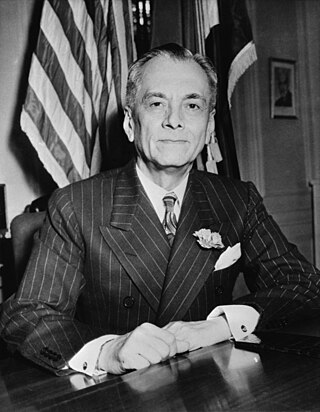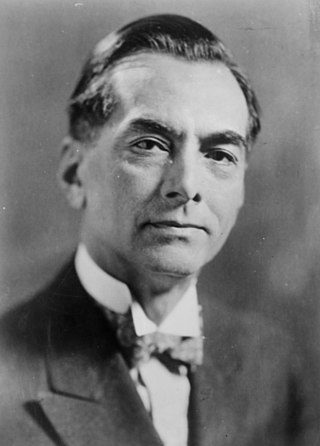
The Commonwealth of the Philippines was an unincorporated territory and commonwealth of the United States that existed from 1935 to 1946. It was established following the Tydings–McDuffie Act to replace the Insular Government of the Philippine Islands and was designed as a transitional administration in preparation for full Philippine independence. Its foreign affairs remained managed by the United States.

Manuel Luis Quezon y Molina, also known by his initials MLQ, was a Filipino lawyer, statesman, soldier, and politician who was president of the Commonwealth of the Philippines from 1935 until his death in 1944. He was the first Filipino to head a government of the entire Philippines and is considered the second president of the Philippines after Emilio Aguinaldo (1899–1901), whom Quezon defeated in the 1935 presidential election.

Sergio Osmeña Sr. was a Filipino lawyer and politician who served as the fourth President of the Philippines from 1944 to 1946. He was Vice President under Manuel L. Quezon. Upon Quezon's sudden death in 1944, Osmeña succeeded him at age 65, becoming the oldest person to assume the Philippine presidency until Rodrigo Duterte took office in 2016 at age 71. A founder of the Nacionalista Party, Osmeña was also the first Visayan to become president.

Gregorio Aglipay Cruz y Labayán was a Filipino former Roman Catholic priest and revolutionary who became the first head of the Iglesia Filipina Independiente (IFI), the first-ever wholly Filipino-led independent Christian Church in the Philippines in the form of a nationalist church.
General elections were held in the Philippines on November 11, 1941. Incumbent President Manuel Luis Quezon won an unprecedented second partial term as President of the Philippines via a landslide. His running mate, Vice President Sergio Osmeña also won via landslide. The elected officials however, did not serve their terms from 1942 to 1945 due to World War II. In 1943, a Japanese-sponsored Republic was established and appointed José P. Laurel as president. From 1943 to 1945, the Philippines had two presidents. Quezon died in 1944 due to tuberculosis and was replaced by Sergio Osmeña.

The 1935 Philippine presidential and vice presidential elections were held on September 16, 1935. This was the first election since the enactment of the Tydings–McDuffie Act, a law that paved the way for a transitory government, as well as the first nationwide at-large election ever held in the Philippines.

Pedro Abad Santos y Basco was a Filipino Marxist politician. He founded the Partido Sosyalista ng Pilipinas (PSP) or Philippine Socialist Party in 1932. He ran for several local elections but never won. He also ran for president in the 1941 Philippine presidential election, but later withdrew, weeks before the election. Luis Taruc of the Hukbalahap Rebellion was under his tutelage and was his right-hand man.
This list of presidential elections in the Philippines includes election results of both presidential and vice presidential elections since 1899 with the candidates' political party and their corresponding percentage.

The Nacionalista Party is the oldest political party in both the Philippines and in Southeast Asia in general. It is responsible for leading the country throughout most of the 20th century since its founding in 1907; it was the ruling party from 1935 to 1946, 1953–1961 and 1965–1972.

The Central Colleges of the Philippines, Inc., also referred to by its acronym CCP, is a private, nonsectarian coeducational higher education institution located in Quezon City, Metro Manila, Philippines. CCP was established in January 18, 1954, and named the Polytechnic Colleges of the Philippines, Inc. (PCP), with an enrollment of 300 students. CCP has eleven academic programs or colleges at present.

The 1946 Philippine presidential and vice presidential elections were held on April 23, 1946, according to Commonwealth Act No. 725. Incumbent president Sergio Osmeña ran for a full term but was defeated by Senator Manuel Roxas. Meanwhile, senator Elpidio Quirino defeated fellow senator Eulogio Rodriguez to become vice president.

Juan Marquez Sumulong Sr. was a Filipino former revolutionary, journalist, lawyer, educator and politician from the province of Rizal. He was the president of the opposition party which ran against Manuel L. Quezon's Nacionalista Party in the 1941 presidential election of the Philippine Commonwealth. He is also the maternal great-grandfather of former President Benigno Aquino III.
Elections for the president, vice-president, members of the Senate, members of the House of Representatives and local positions were held on April 23, 1946, pursuant to Commonwealth Act No. 725
Presidential, legislative and local elections were held on November 14, 1961 in the Philippines. Incumbent President Carlos P. Garcia lost his opportunity for a second full term as President of the Philippines to Vice President President Diosdado Macapagal. His running mate, Senator Gil J. Puyat lost to Senator Emmanuel Pelaez. Independent Candidate Cebu City Mayor Sergio Osmeña, Jr. ran for Vice President also lost by a narrow margin. Six candidates ran for president, four of whom were "nuisance" candidates. This was the only election in Philippine electoral history in which a vice-president defeated the incumbent president.
1946 in the Philippines details events of note that happened in the Philippines in 1946.
The Democrata Party, also known as Partido Democrata Nacional was a political party in early 20th century Philippines, when the Philippines was an insular territory of the United States. It functioned as an opposition party against the ruling Nacionalista Party.
The National Socialist Party was a political party in the Philippines. It served as the political vehicle of Emilio Aguinaldo, president of the First Philippine Republic in the 1935 Philippine presidential election.
The Republican Party was a political party in the Philippines. It was founded by labour activist and writer Isabelo de los Reyes, whose leadership was shortly turned over to Gregorio Aglipay, the first Supreme Bishop of the Philippine Independent Church. Isabelo de los Reyes founded the party in 1905, with Gregorio Aglipay taking over the leadership shortly thereafter. Both were members of the Philippine Independent Church. The party was subsequently banned by the United States Insular Government after the 1907 elections. In the first ever nationwide at-large election held in the Philippines, the 1935 presidential election, Aglipay revived the Republican Party and was the last presidential candidate to announce his candidacy. The party was supported by the Coalition of the Oppressed Masses. This coalition originally included Emilio Aguinaldo and his National Socialist Party, but Aguinaldo split from the party and launched his own presidential campaign. Aglipay's party had connections with labor unions in Manila.
Raymundo Melliza was a Filipino lawyer and politician who served as the second governor of Iloilo during the American occupation of the Philippines and was also an unsuccessful candidate for Vice President in the 1935 elections as a running-mate of former President Emilio Aguinaldo.













